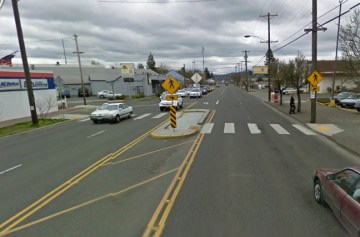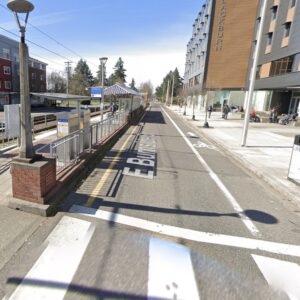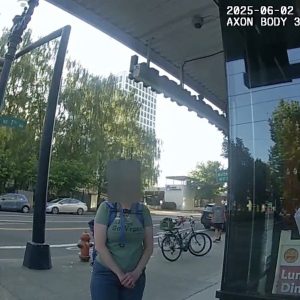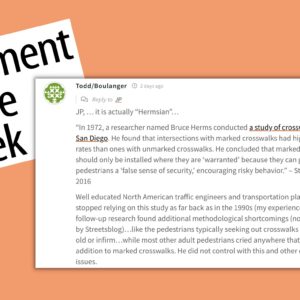
on SE Foster.
The Portland Bureau of Transportation (PBOT) and the Portland Police Bureau (PPB) held one of their regularly scheduled “crosswalk enforcement actions” yesterday. This excellent program, run by the PBOT traffic safety team and dedicated staffer Sharon White (who often puts herself at risk on our most dangerous roads as a decoy during the missions), has resulted in nearly 1,000 citations since it began five years ago.
The set-up is your typical sting situation, except that it’s not exactly a sting. The reason we call these “enforcement actions” is because both the PPB and PBOT give plenty of prior warning that the missions are happening. They notify the public about them via the local media and they even set up signs at the locations announcing that an enforcement is ahead. The goal, says the City, is not to fill the City’s coffers busting scofflaws, but rather to increase awareness among road users of traffic safety and the laws that govern it.
Yesterday’s mission was held on SE Foster Road between SE 68th and 69th.
This is a notoriously dangerous and high speed arterial that has claimed several lives over the years. In fact, this enforcement mission was scheduled for this past February, but in a twist of tragic irony, it was postponed due to a fatal hit-and-run just one week prior. Mayor Sam Adams has dubbed this road the “Foster freeway” (Foster is also where former NFL player and UO star Joey Harrington was hit while bicycling last summer and where two women were killed while walking back in 2009.)
To give you an idea of just how rampant law-breaking is (especially on these high-speed arterials), in just about one hour of work last night, the PPB issued 13 citations and 9 warnings. Here’s how they broke down (taken from PBOT report):
– 8 Fail to yield to ped in crosswalk,
– 2 Fail to maintain safe distance from Emergency Vehicle
– 1 Cell phone,
– 1 Improper right turn,
– 2 Fail to display plate,
– 1 Fail to carry insurance,
– and 9 warnings (7 Fail to yield to ped in crosswalk, 2 Endanger child passengers (seatbelts)
In my opinion, this level of disregard for both laws and for the safety of fellow citizens is not surprising, but still shocking, and it should spark outrage among city leaders and the media. Yet, these enforcement actions happen every month and we rarely see them in the headlines.
— PBOT’s enforcement actions are part of their StreetSmart – Go Safe program. Learn more about it on their website.







Thanks for reading.
BikePortland has served this community with independent community journalism since 2005. We rely on subscriptions from readers like you to survive. Your financial support is vital in keeping this valuable resource alive and well.
Please subscribe today to strengthen and expand our work.
But wait: bikers blow stop signs all the time! And they’re dirty hippies, too!
Is this The Oregonian comments section?
Thanks PBOT (Especially Sharon) for doing these. I wish they could be done daily all over the city. It seems that it would not only pay for itself, but it would make the roads much much safer.
It would be interesting to know if the police had radar and were checking for speed, too. Probably not, or they’d have to pull over 90% of the cars.
Unfortunately, enforcement actions like these, as satisfying as they might be, don’t generally lead to higher rates of compliance unless they’re done with such frequency and in so many areas that PPB resources would be completely consumed by the task. (If they pay for themselves, maybe this could be a great job creation plan, though!)
Road design is the only real solution. For crosswalk compliance, make it so the driver WANTS to stop at the crosswalk, because it’s so annoying not to. That is, all crosswalks should be at a grade change. Think wide speedbumps, with crosswalks on top of them, visually obvious to everyone from a distance.
I’d be happy to see some dedicated staff for full-time crosswalk enforcement, assuming they’re able to pay their way with fines.
No significant increase in enforcement will occur until the legal road blocks to automated traffic violation assessment systems (red light cameras, unmanned photo radar) is removed so that the boring, mundane, repetitive traffic ticketing process is streamlined.
Traffic violators WILL ALWAYS out number police.
Are you suggesting that all crosswalks should be built up into large speed bumps? I would totally support that.
Having crosswalks on wide speedbumps wouldn’t be a terrible idea as it would cause users of the crossing to be elevated in drivers’ vision and encourage vehicles to slow down prior to the crossing (even if due to “speed blindness” or whatever that phenomena is called where moving persons have difficultly discerning slower, non-moving objects in their vision).
I am disappointed that all of these enforcement actions take place at marked crosswalks. Please do some of these at unmarked crosswalks. The level of compliance I see daily at unmarked crossings is near zero.
Completely agree! Especially since there are places in Portland where you can go 10-20 blocks without a single marked crosswalk.
Guys, guys–come on! Drivers cannot be expected to remember anything from the Driver’s Manual, let alone know actual laws that pertain to driving! No signs, no stripes, no rules–isn’t that how it works?
/s
Yet they somehow remember exactly EVERY law that cyclists are supposed to follow, including non-existent ones…
Why are (or were?) the stings meant to catch people on bikes failing to stop at stop signs (with no pedestrian cross traffic decoys) in Ladd’s not pre-announced with media blitzes and signage? Seems kind of (predictably) lopsided, no?
I think the “bike stings” were organized by the police dept, while these crosswalk enforcement actions are organized by PBOT. This may explain their differences in notification and process.
One of the ways I deal with my frustration about bad behavior by people in cars: I am extra courteous and friendly to pedestrians. Even if cars don’t stop when they are supposed to for pedestrians, I do. Typically I get a grateful smile from the pedestrian, and I get to feel like a smug, law-abiding cyclist surrounded by scofflaw drivers.
Did that on NE Knott just last night. Stopped for a father and his toddler and baby in a stroller, waiting for a break in traffic at an unmarked crosswalk. I signaled a very obvious stop and then was passed by one, two, then three cars that couldn’t care less – who were all stopped by a red light only one block away. It’s ridiculous.
There shouldn’t be anything special about this behavior: it’s the law. I am extra vigilant about stopping for pedestrians whether I’m driving or cycling.
I will say that being a frequent cyclist and pedestrian has made me a more patient person behind the wheel and a firm believer in sharing the road with all users. I only get annoyed now when I’m slowed down by inattentive/distracted/incompetent motorists, not by pedestrians or cyclists.
One cell phone talker? I call BS on that.
I want to give a big Thank You! to Sharon White at PBOT for doing this work. Enforcement action such as this give us real-world numbers to back up the hazards we see everyday on our streets.
That said, if we were serious about safety, we’d do more than just track how dangerous our streets are. Multi-lane streets are hazardous – especially in areas that are supposed to be walkable main street neighborhood centers. Unless there is a dense system of signals to manage speed and crossings, streets should be limited to a single motor vehicle travel lane in each direction. Yes, this would slow drivers down, but it would be worth it for the added safety for everyone.
I have a crazy idea. They should some how make it so when you hit the walk button it sends a recording, like “person in crosswalk” into the car that plays through the radio or bluetooth.
Or starts a recording device that snaps shots of license plates and mails tickets.
In Denmark and the Netherlands major diagonal arterial routes like Sandy and Foster would have nice fancy bike lanes, signalling, and traffic calming. These streets are among the most efficient ways to reach large swathes of outer Portland from the inner core. They are absolute hell for cyclists and pededtrians. Why is Williams a priority but not Foster?
“Why is Williams a priority but not Foster?”
Because Foster is past 39th. The amount the city cares and spends $$ get progressively less each block past that.
That doesn’t explain the lack of attention given to Sandy west of Hollywood. Oh right, we wouldn’t want to ruffle any feathers by taking away precious auto capacity.
To a certain extent this is also true each block south of Powell. There is nearly no bike infrastructure out in Brentwood-Darlington.
WE have bike lanes on most major streets (Duke, 52nd, Flavel, and 92nd (granted that’s Lents). Yes they could put some lanes in 72nd, but I really don’t have a lot of problems biking in my neighborhood. I live on Duke and am very happy with the bike lane there. Granted a neighborhood greenway would be nice for families.
Foster has the unfortunate circumstance of being past 39th AND south of Powell. The double whammy! I’m just waiting for the resurgence though. The area by Mt. Scott park (72nd and Harold) is slowly building up to a nice little neighborhood area.
The majority of Portlanders could not probably tell you where Brentwood-Darlington is. I get lots of “is that in Portland”‘s and “where?”.
“This level of disregard is shocking”, why? Shocking because it is so common and acceptable and we all participate, to some degree.
There should be a two-hour enforcement action at some crosswalk in the city EVERY day, not just one day per month. They could go to some high pedestrian use areas and they wouldn’t even need decoys. I suggest SE Woodstock near the library. One motorcycle cop could snag four motorist violators per hour without any extra help. I’m sure others could nominate dozens of locations. Despite the mayor’s statements, ped safety is not an enforcement or judicial priority.
Sometimes it takes courage to stop. As a person on a bike, would you risk your own life to stop at a crosswalk for a pedestrian?
I’m asking beecease I work on 4th Ave near PSU, and when I ride home in the evening, it’s three lanes of downhill road heading one-way northbound, and all vehicles (bikes included) are going 20-30 mph. There are two heavily used crosswalks at Mill and Montgomery. When I see a ped waiting to cross I first look over my shoulder to see if I’m being “tailgated” and many times I have to make a decision whether I feel it is safe to stop or not – some times I do not stop. It is my opinion that these two crosswalks are dangerous for both peds and bikes but I don’t have a solution on how to fix it. I would like to know if you travel this route and have experienced the same thing.
We have had “stings” at 4th and College that are pretty successful, but it is a safer crossing because people are aware they are on the PSU campus and the road is flatter.
usually it is possible to stop for the pedestrian without “risking your life.” if you have asserted a space sufficiently to the left in the travel lane, you should have lots of room to bail to the right as you signal and stop. if possible, of course, you should try to make it almost necessary for the motorist to also stop, but as you say, sometimes this can involve risk, which no one should voluntarily take. except if the pedestrian you are stopping for is some kid chasing a ball. then you have to weigh stuff.
You are kidding. This HAL9000 super computer stops all the time going downhill on 4th avenue.
However, I recommend biking down 10th. There is less traffic. Unless you can’t handle streetcar tracks, that is.
If you’re going 20 miles an hour in downtown, you’re speeding. Just slow down.
If you’re riding on 4th ave downtown heading north then you know that the lights are timed at 12mph, so the chances of someone doing 30 or pretty remote.
“Shocking”? How so? Sloppy dangerous driving is the norm. If this were a regular news blog instead of one on bicycling, you’d be getting an earful from self-righteous folk who claim that traffic enforcement is all a scam to extort ticket money from honest drivers. The fact that people can rationalize destructive behavior shouldn’t be news to you.
Next time I hear someone whine about people on bikes running stop signs, I’m going to point them to this article.
And next time I’m crossing the street and I nearly get run over by a bicyclist ignoring stop signs and crosswalks, I’ll say “Bad behavior by motorists doesn’t excuse bad behavior by bicyclists.”
Not effective 24 hours later. I just stood in the island while 13 westbound motor vehicles zipped in front of me at 30 miles/hour.
If you’re standing in the island, they aren’t required to stop. You have to be actually *in* the roadway. That’s one reason why the Willamette Pedestrian Coalition and other pedestrian groups have worked to change Oregon law to enable the use of hand signals to assert a pedestrian’s right to the roadway without having to actually step in front of fast-moving traffic.
“Endanger child passengers” is only a warning? sounds like it should be an arrestable offense…
No, no, a thousand times no. Don’t play blockade games. It’s a good way to provoke road rage and a bad way to change people’s behavior.
did not mean to suggest playing a “blockade game.” that is why i said “almost necessary.” the motorist (probably) has not already seen the pedestrian, and will need some kind of cue that something is going on. my practice has been to move a bit to the left and signaling the stop before again fading right. what you emphatically do not want to do is create an impression in the pedestrian that it is safe to cross just because someone on a bike is stopping.
FUD
i have been confronting egregious motorist behavior for a very long time. none of these interactions have resulted in violence and many have been positive.
As Amanda Fritz would say: “Until motorists start obeying the laws of the road, I cannot support providing any more funding for motorist projects.”
I thought she said “bikes”.
She did, which is why I voted for Mary Nolan.
jonathan,
I’m glad to see the enforcement, but like some posters above, I don’t find this “shocking” at all. There are a lot of traffic laws that are routinely ignored by drivers, bikers, and pedestrians.
The thing about this one is how directly it may correlate with safety.
I drive that corridor regularly. It is a heavy commuting route–along with Powell, Foster is really the only good E/W corridor from the inner SE to I-205. With four lanes, a divider, and traffic, and travel speeds around 35mph, a driver has enough to pay attention to without also scanning the sidewalk.
I understand that we need to, and I am trying to train myself to scan to the sidewalk on either side of the road at crosswalk, but it is definitely a challenge.
Some sort of visible indication that a pedestrian is trying to cross would be invaluable.
My suggestion for roads with average speeds around 35 MPH and which are major commuting corridors (in the SE: Powell, Division, Foster, Burnside) would be for the city to invest in flashing yellow lights attached to the central sign or ideally the overhead flashing pedestrian sign.
Why don’t we just lower the speed limit? Then it’d be easier and safer for you to see what’s going on around you, including on sidewalks and in crosswalks.
So you say Foster is the only good connector to 205, but then include Powell and Division in your statements?
OK, so it seems many of you I think misread my “shocking” comment. Obviously I am not shocked — as in surprised — by how much law-breaking there is on the roads. The “shock” part is more from the fact that we all know it’s going on and it’s just accepted. Accepted while people die and get hurt every day by it. Sorry if my use of “shocking” threw folks a bit.
I heard this disturbingly summed up as “roadkill is the price of progress”.
I find it shocking that people are so stupid. I mean they are warned by a sign ahead of this area, and then still do dumb illegal things. If you’re warning them ahead of time, you really can’t do much else to help them.
In my opinion we need to start filling the “city’s coffers busting scofflaws”. We need to step up enforcement for crosswalks, speeding, running stop signs/lights, talking on cell phones, ect. In my opinion enforcement is seriously lacking and we should be looking to fund more enforcement through the wallets of those that violate the laws.
We could pay for all the paving we need by issuing more of these sort of tickets!
Thanks, Jonathan, for providing the break down citations. I’m surprised that there weren’t more cell phone violations.
Thanks for the targeted enforcement action. I am surprised at only 1 cell phone citation.
Looking at the photo of this arterial pedestrian crossing…how about making some important and cost effective enhancements?
– adding an advance stop bar (30′) in advance of the crosswalk
– changing the dashed white lane line into a solid thermoplastic lane line on the approach (so drivers would not be allowed to change a lane and pass a stopped car waiting for a pedestrian)
– check if there is adequate street lighting on the left side of the street for a crossing
– and if driver stopping for peds compliance is lower than desired see if adding a R1-6a sign on the shared lane line for each approach (this is permitted in the MUTCD vs the more common placement on the island.)
Good suggestions Todd, and worthy of implementation, but I wonder if we’re just putting lipstick on a pig here. Foster can be an amazing (and safe) street, but improving the existing crossings are not going to get it there. The single most important change we could do would be to reduce the number of travel lanes from Four to 2 (or 3)…everything else is band-aids on a broken leg.
These enforcements, which are desperately needed on Foster around 82nd, in addition to many other locations, will only have impact when repeated ad naseaum. Until them, motorists will simply be pissed they got popped in a PoPo / PBOT action and not really learn the dangers of speed and inattention behind the wheel of an automobile.
Since I began my research into crash statistics after my son Dustin’s death by car/driver, I have been “shocked” myself by how commonplace motor vehicle crashes are and how hardly anyone seems to really notice. You’d think there would be more outrage, at least more concern, that crashes are the #1 cause of death of sons, mothers, sisters, husbands, cousins, co-workers and friends, between the ages of 2-34. But I hardly noticed prior to our family’s tragedy, either. I’d be horrified by what I saw in the news, I’d deliberately make myself not think too hard about it (because the thought of losing one of my own loved ones was too terrible to contemplate), and I never ever really thought about what was causing these collisions. Now I don’t have that luxury. Real people are killing and seriously injuring other real people, and I can’t get away from that knowledge anymore. Ever.
I wish others couldn’t either. If others could just feel what I felt on Mother’s Day, a day on which I honestly was afraid I would not be able to stop crying, to stop feeling as if I wanted to die myself, there would be far fewer fathers and daughters and grandmothers and uncles running stop lights and talking on cell phones and driving drunk and speeding. It would be nice if we didn’t have to learn the hard way. Like I did.
Thank you for channeling your grief into something positive. Your writing here has been brilliant, heartfelt, and important. Keep at it, Kristi.
Kristi – thanks so much for getting involved. Your son’s death is a tragedy, and I think most cyclists would agree that the situation is unacceptable. It took a multi-year effort across a large swath of society to address drunk drivers in the 1980s and 1990s – initially it wasn’t viewed as a problem, even though drunk driving was (and still is) killing thousands of people each year.
Speed limits are set too high, and more to the point – regardless of where they are set, people drive/ride too fast. Driver education is woefully inadequate. Enforcement is inconsistent. All road users don’t pay enough attention to the road/sidewalk/path. Cyclist and pedestrian training is nonexistent. Very large trucks are allowed in areas where they cannot be safely operated. And there is no effective mechanism to limit a dangerous road user and prohibit them from operating vehicles larger that they can safely operate.
Drunk driving was curtailed through a lengthy process where we made it socially unacceptable to drive drunk. To correct these problems, we likewise need to all create a social climate where it’s not acceptable to drive inattentive, or to drive large vehicles above safe speeds. One where motorists respect those outside an enclosed vehicle, where cyclists respect pedestrians, and where pedestrians don’t inattentively wander into the street. ALL parties are culpable, and while the most immediate results will come from focusing on cars and trucks, action at all levels is necessary and warranted.
Fundamentally, the problem is that we as a society, and many of us as individuals, fail to respect that there are others on the road – and that their needs and wants are as valid and important as ours.
Matt, I agree with that and I know from your previous posts that you’d also include stricter enforcement of the Basic Rule among those safety provisions. Unfortunately, our society may not yet be moving in that direction, in fact still moving to allow even more leeway to motorist-caused tragedy. At least as far as Washington State legal codes, The Waitsburg Times had this to say about a recent court decision in the case of a driver hitting and killing a rider (emphasis added):
To convict Bohleen, the prosecuting attorney would have had to prove that Bohleen disregarded others’ safety beyond a reasonable doubt when he hit Eustis on her bicycle, a higher, more aggravated kind of negligence than normal because of a recent change in state law.
It’s angering when you are walking across the street and a car buzzes you with out slowing or moving over or anything. 🙁
The flashing yellow crosswalk lights installed near Foster and 82nd work quite well – most drivers do stop for them. More please!
I’ve found that crosswalk to work well too. I wonder how much pull Fred Meyer’s had in getting it installed though.